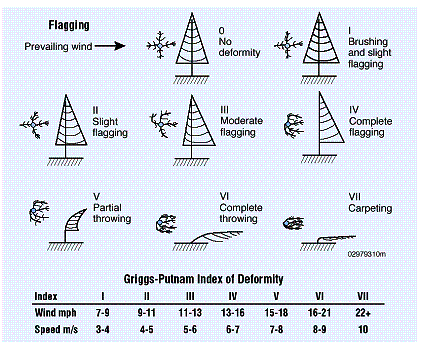
One of the first scales to estimate wind speeds and the effects was created by Britain's Admiral Sir Francis Beaufort (1774-1857). He developed the scale in 1805 to help sailors estimate the winds via visual observations. The scale starts with 0 and goes to a force of 12. The Beaufort scale is still used today to estimate wind strengths.
| Beaufort Force | Description | Effects on land | knots | km/h | mph | |
| 0 | Calm | Smoke rises vertically. | Less than 1 | Less than 1 | Less than 1 | |
| 1 | Light Air | Direction of wind shown by smoke drift, but not by wind vanes. | 1 - 3 | 1 - 5 | 1 - 3 | |
| 2 | Light breeze | Wind felt on face; leaves rustle; ordinary vanes moved by wind. | 4 -6 | 6 - 11 | 4 -7 | |
| 3 | Gentle breeze | Leaves and small twigs in constant motion; wind extends light flag. | 7 - 10 | 12 - 19 | 8 - 12 | |
| 4 | Moderate breeze | Raises dust and loose paper; small branches are moved. | 11 - 16 | 20 - 29 | 13 - 18 | |
| 5 | Fresh breeze | Small trees in leaf begin to sway; crested wavelets form on inland waters. | 17 - 21 | 30 - 39 | 19 - 24 | |
| 6 | Strong breeze | Large branches in motion; whistling heard in telegraph wires; umbrellas used with difficulty. | 22 - 27 | 40 - 50 | 25 - 31 | |
| 7 | Near gale | Whole trees in motion; inconvenience felt when walking against the wind. | 28 - 33 | 51 - 61 | 32 - 38 | |
| 8 | Gale | Breaks twigs off trees; generally impedes progress. | 34 - 40 | 62 - 74 | 39 - 46 | |
| 9 | Strong gale | Slight structural damage occurs (chimney-pots and slates removed). | 41 - 47 | 75 - 87 | 47 - 54 | |
| 10 | Storm | Seldom experienced inland; trees uprooted; considerable structural damage occurs. | 48 - 55 | 88 - 101 | 55 - 63 | |
| 11 | Violent storm | Very rarely experienced; accompanied by wide-spread damage. | 56 - 63 | 102 - 117 | 64 - 73 | |
| 12 | Hurricane | Whole hangars disappear. | >64 | >119 | >74 |
the Griggs-Putman index of deformity provides information on average wind speeds.

Given an obstruction of height H, the air will generally be disturbed in an area roughly bell shaped with a height of up to 2H over an area that starts 2H before the obstruction and continues for 20H after it. On the other hand, a smoothly rolling hill will concentrate the wind at the peak and provide higher velocities at the hilltop.
Also: